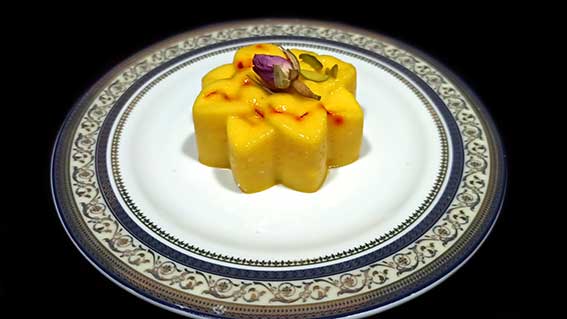Getting to know the different uses of saffron
In the past, saffron was not only used to make food fragrant and colorful, but it was also used to perfume the body and even treat diseases such as insomnia. Currently, saffron still has a variety of uses and it is widely used for beautifying and rejuvenating the skin, treating diseases, and of course adding color and glazing to foods. Follow along to introduce you to the various uses of saffron .
Nutritional value of saffron
c00000Saffron is rich in vitamins and minerals. Copper, calcium, manganese, iron, zinc, magnesium and many other minerals are found in saffron. Saffron is also rich in antioxidants and contains many vitamins such as vitamin A (A) , folic acid, vitamin B2, vitamin B3 and vitamin C (C ) . Carotene, lycopene, zeaxanthin, eucalyptol, pinene, bernol, graniol, limonene, cimen and linanol are other chemical compounds found in saffron, which are the source of the antioxidant properties of this precious spice .
Type of material |
Amount per 100 grams |
|
energy (calories) |
310 kcal |
|
fat |
5.84 grams |
|
Protein |
11.43 grams |
|
carbohydrate |
65.3 grams |
|
Dietary fiber |
3.9 grams |
|
sodium |
148 mg |
|
potassium |
1724 mg |
|
Calcium |
111 mg |
|
iron |
11.10 mg |
|
copper |
0.328 mg |
|
magnesium |
246 mg |
|
Manganese |
28.4 mg |
|
Vitamin B6 |
1.01 mg |
|
Vitamin A |
530 international units |
The most important use of saffron can be divided into three categories: culinary, therapeutic and cosmetic :
Cooking with saffron
In addition to the high nutritional value of saffron, its taste and aroma are also very important in cooking . It is interesting to know that in the Middle Ages, to eliminate the bad smell of stored food (which quickly spoiled due to the lack of a refrigerator), saffron was used to make it tasty. Currently, the use of saffron spice is very common in Asian and European cuisines. Saffron color is used as a natural color for yellowing various sweets, soup, rice and many other foods . From the Qajar era onwards, saffron has been used in cooking food and all kinds of food such as saffron ice cream, saffron syrup, saffron muscat, etc.
The use of saffron is very common in Iranian, Indian, and Arabic cuisines because of its aroma and taste, and saffron can be considered one of the main spices in the preparation of various types of food in these countries.




Therapeutic properties of saffron
Traditional medicine has used a lot of saffron in the past. For example, the Sumerians used saffron to prepare therapeutic and healing potions. Currently, many scientific and medical researches have proven the healing properties of saffron. Saffron is one of the main sources of antioxidants. The antioxidant property of saffron comes from crocin, picrocrocin and safranal in its flower. In general, it is said that saffron is effective in treating cough, asthma, cancer, reducing menstrual symptoms , strengthening sexual powers, treating depression and insomnia. Based on studies of oral consumption of saffron, because it has anti-inflammatory properties, it can reduce Alzheimer’s symptoms over time.


Preventing high blood sugar and reducing high blood pressure are other therapeutic properties of saffron. Also, saffron can improve asthma symptoms and prevent coughing. However, the healing properties of saffron are not only limited to physical health. But saffron is also very effective on mental health .
According to research, one of the most important therapeutic properties and uses of saffron is to reduce the symptoms of depression. It seems that saffron has a better performance than antidepressants such as fluoxetine and citalopram in the treatment of depression .
Antioxidants in saffron can improve mood by increasing brain dopamine levels.
Saffron and skin beauty (cosmetics)
Other uses of saffron include its use in cosmetic and skin care products. The sweet and warm scent of saffron is used in the preparation of various colognes. Also, its yellow and golden color is used to prepare cosmetic products such as lipstick and blush. Ancient Iranians used saffron to perfume their bodies. Crocin and kaempferol are chemical compounds that are widely used in the preparation of cosmetics. While saffron is also rich in these two chemical compounds. Saffron can protect the skin from the sun's ultraviolet rays. According to research, saffron has a better performance than sunscreens.

The moisturizing properties of saffron
Saffron also has moisturizing properties and can maintain the moisture of the skin and prevent it from drying out. The antioxidant property of saffron is also effective in treating acne and protecting the skin against skin cancer. Saffron can also make the skin clearer and brighter by reducing skin melanins. This is why saffron is used as the primary ingredient of skin lightening creams. It is said that saffron can improve blood circulation in the skin and has exfoliating properties. For this reason, it seems that saffron is effective in preventing skin aging and has rejuvenating properties. It is not without reason that saffron is used in the preparation of facial masks and rejuvenating creams.

Use of saffron perfume
Saffron was used as a perfume in public places such as courts and halls. Making perfume with saffron by the inhabitants of the shores of the Mediterranean Sea in the ancient world, smoking saffron along with musk and amber in the environment to make the environment fragrant (in one of the petroglyphs in front of Persepolis, the image of a dish in which saffron was smoked was engraved)
